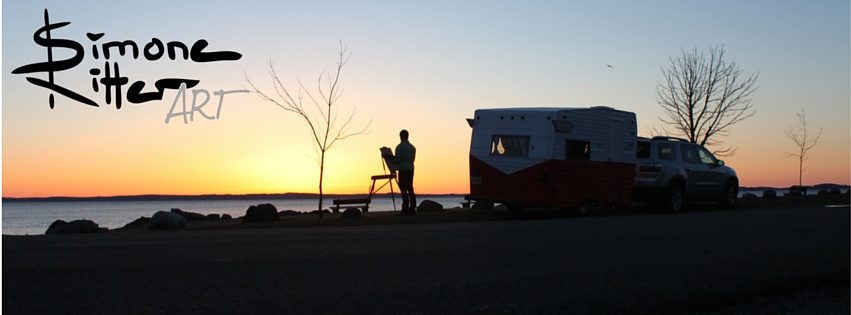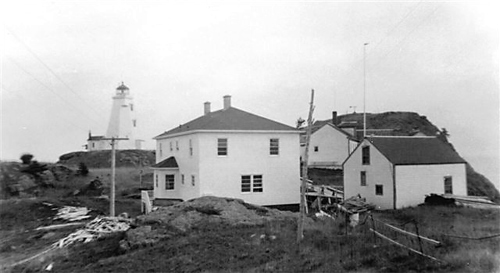Swallowtail Lighthouse, Grand Manan, NB
orig. watercolour, 5x13in approx.
see it at my show at Sunbury Shores Art from May 6-20, 2016
Here, another regional favourite, Swallowtail Lighthouse on Grand Manan Island.
I have written about my visits to Grand Manan in an earlier lighthouse-post where I featured the Long Eddy Light. You can read about it here.
This is the most iconic island lighthouse and the ferry runs right by it as it approaches the harbour behind its outcrop.
Below you can read more info from the www.lighthousefriends.com website
Anyone who has ever traveled to Grand Manan has been welcomed to the island by the Swallowtail Lighthouse, which overlooks the entrance to North Head Harbour, but few today know the amazing history of this beacon or appreciate the hardships endured by its dedicated keepers.
Tragic Strikes:
The 1,009-ton three-masted Lord Ashburton, which had been built near St. Andrews, was en route from Toulon, France to Saint John when it foundered on the northern shore of Grand Manan during a gale at 1 a.m. on January 19, 1857. A member of the crew, James Lawson, climbed the rocky headland, now named Ashburton Head, near where the ship grounded, and stumbled a mile to Long Eddy, where he collapsed in a hay barn. His body was discovered later that morning, and a search launched that resulted in seven other members of the crew of twenty-nine being saved, though they were badly frozen. A memorial to the twenty-one seamen aboard the Lord Ashburton who drowned at Grand Manan can be seen in the cemetery at the Anglican Church in North Head. James Lawson, a Dane, had both his feet partially amputated, and after spending over five years recuperating at the marine hospital in Saint John, he returned to Grand Manan, married an islander, and worked as a shoemaker.
The Ashburton disaster punctuated the need for a navigational aid on the northern end of Grand Manan. The government authorized that steps be taken “to ascertain the propriety of establishing a Light House on the Northern Head of Grand Manan” and to pursue the construction of such a structure if advisable.
Plans and specifications for the proposed lighthouse were drawn up in 1859, and arranged to purchase up to four acres, at a cost of $25 per acre, from James Small, the owner of the property.
After the lantern was successfully installed atop the octagonal tower, the lighthouse had its inaugural lighting on July 7, 1860. The wooden tower stands forty-five feet high and is perched 103 feet above the water, giving it a focal plane of 148 feet. A bridge to connect the point on which the lighthouse stood to the headland was constructed in 1861.
|
Swallowtail Lighthouse was in first-rate order when the Saxby Gale struck on October 4, 1869. The hurricane, accompanied by an unusually high tide, created a two-metre surge that caused significant damage in the Bay of Fundy. The keeper’s dwelling was so shaken by the storm that two chains were strung over the roof and secured to the rock on each side to keep it in position. The foundation of the lighthouse was significantly damaged, necessitating the construction of a substantial stone wall, resting upon the underlying solid rock, beneath the tower. Keeper Jonathan Kent retired in 1873 and was replaced by his son, John W. Kent, who initially earned an annual salary of $400.
Keeper Kent regularly received praise in the annual reports of the Department of Marine. The following example is from 1877: “Everything at this Station is in first class condition, and Mr. Kent takes great pride in keeping this Station, and its appurtenances in good order. He is a man of good taste, and this Station is visited by great numbers of strangers and excursionists who come to the Island during the summer season. Mr. Kent had given the lighthouse a coat of paint, which had lightened it up and greatly improved its appearance. Altogether, this Station may be considered the model station of the Department.”
Tragedy struck Swallowtail Lighthouse in August of 1936 when Elodie Foster was tending the light while her husband was away at Southwest Head Lighthouse. Elodie accidentally overfilled the light’s alcohol burner, and when she attempted to ignite the fuel, her clothes caught on fire. She managed to make it down the tower’s stairs and outside the lighthouse where she soon received help from her son Leonard and two daughters. Leonard raced up the tower and managed to extinguish the flames in the lantern room before the fire spread to the tower. Sadly, Elodie passed away the next day from her burns.
After filming the horror film Hemoglobin at the lighthouse in 1996, the movie producers paid to have the keeper's dwelling restored. Soon thereafter, the dwelling opened as the Swallowtail Inn, a bed and breakfast run by islanders Catherine Neves and her sister Crystal Cook. After operating for nearly a decade, the inn was shuttered in 2004, and the dwelling now sits vacant.
In March of 2008, the village council announced that the keeper's dwelling would be sold as upkeep was proving to be too expensive. Repairs had cost the community $80,000 in recent years. A well-publicized meeting was held on April 4th to come up with ideas to save the dwelling and resulted in the creation of the Swallowtail Keepers Society whose mission is to rejuvenate Swallowtail Lighthouse and make it a symbol of civic pride for the island. The village council, a bit surprised by the islanders' feelings on the matter, rescinded the motion to sell the keeper's dwelling during their April 7th meeting.
During 2013, the society received over $200,000 from various sources, including the provincial and federal government, to improve the footbridge, construct a boardwalk, produce marketing materials, and cover administration costs. (info: Lighthousefriends.com)



No comments:
Post a Comment